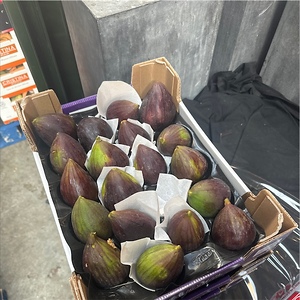


Black Beauty Figs
Estimated Inventory, lb : 0
Description/Taste
Black Beauty figs are a small to medium-sized varietal, averaging 2 to 5 centimeters in diameter, and have a pyriform appearance with a bulbous, curved base tapering to a smaller, rounded neck. The skin is thick, taut, and lightly ribbed, showcasing red-purple hues, almost appearing black. The skin is also covered in a faint blue-grey bloom and may sometimes show thin, light brown cracks, depending on cultivation. At the base of the fig, there is a small, closed eye, also known as an ostiole. Figs are technically a syconium, which is a mass of tiny undeveloped flowers enveloped in edible skin. The soft, sticky, aqueous, and textured flesh has burgundy and cream-colored hues. The flesh also encases many small seeds, creating a dense, creamy, and crunchy consistency. Black Beauty figs release a sweet, fruity, and floral aroma and have high sugar content, creating a sweet, honeyed, berry-like flavor with jammy, melon-like nuances.
Seasons/Availability
Black Beauty figs are available in the spring through summer.
Current Facts
Black Beauty figs, botanically classified as Ficus carica, are a rare variety belonging to the Moraceae family. The fruity and sweet figs were discovered in Southern Louisiana sometime in the late 20th and early 21st centuries and are a specialty cultivar prized for their flavor, texture, and growth characteristics. Black Beauty figs are an early season fig, an important attribute for short-season regions, and are fast-growing and prolific. The figs also do not have fig mosaic emaravirus, known as FMV, and have closed ostioles, the small eye on the bottom of the fruit. Closed ostioles inhibit the fruits from taking in humidity and excess water from rain, causing the fruits to split. Black Beauty figs are challenging to find, and only a few growers in the United States cultivate the variety. The figs are versatile, used in fresh and cooked preparations, and are grown in small quantities in home gardens and select farms.
Nutritional Value
Black Beauty figs are a source of calcium to build strong bones and teeth, vitamin C to strengthen the immune system while reducing inflammation, and vitamin A to maintain healthy organ functioning. The figs also provide potassium to balance fluid levels within the body, copper to produce red blood cells, vitamin K to assist in faster wound healing, and other nutrients, including magnesium, B vitamins, phosphorus, and iron. Beyond vitamins and minerals, the tiny seeds within the flesh act as a natural digestive cleanser.
Applications
Black Beauty figs have a sweet and fruity flavor suited for fresh and cooked preparations. The fleshy figs are popularly consumed straight out of hand, or the soft flesh can be spread onto crackers, cheese, or toast as a snack or appetizer. Black Beauty figs can also be chilled and sliced into yogurt, added to green or fruit salads, used as a pizza topping, or used as a texture in dips and creams. Try dipping Black Beauty figs whole in chocolate and sprinkling with sea salt. Black Beauty figs can also be simmered into syrups, glazes, preserves, and sauces, or they can be caramelized and served with roasted potatoes or meat. In addition to cooked sauces, Black Beauty figs can flavor tarts, cookies, cakes, and other desserts, or they can be blended into ice cream or candied. The figs can also be dried into a chewy texture or pickled for extended use. Black Beauty figs pair well with fruits such as strawberries, nectarines, raspberries, persimmons, pears, and oranges, cheeses including mascarpone, brie, and gorgonzola, spices such as cardamom, cinnamon, and cloves, and herbs including cilantro, thyme, dill, and rosemary. Whole, Black Beauty figs have a short shelf life and will keep 2 to 3 days when stored in a cool and dry place away from direct sunlight. The figs will also keep up to one week when stored in the refrigerator's crisper drawer. For prolonged storage, Black Beauty figs can be frozen for one year.
Ethnic/Cultural Info
Black Beauty figs were named Black Beauty 10 figs by their discoverer. The numbered moniker was derived from the fig's dark coloring and aesthetically pleasing nature. The number 10 was added at the end of the name as Dan, discoverer of the variety and fig enthusiast, rated the cultivar a "10" in terms of flavor. After its release, Black Beauty figs were also nicknamed BB-10 and Dan's BB 10 among fig growers in Louisiana. Beyond Black Beauty, figs, in general, are one of the most popular home garden trees in Louisiana. The southern state provides a climate suitable for fig cultivation, and the trees are popular for their low maintenance but prolific nature.
Geography/History
Black Beauty figs were discovered in Southern Louisiana in a home garden in the Baton Rouge area. The variety's origins are unknown, but a fig enthusiast named Dan, also known as Cajun Dan, found the fig tree in a backyard. According to online writings from Dan, the property owner detested figs and said the previous owner had planted the tree. Dan collected cuttings from the tree and began propagating the variety under the name Black Beauty 10. The first few online posts about this variety appeared around 2010. As news of the figs spread, Black Beauty became a highly sought-after specialty cultivar, with cuttings sometimes selling for over $100. Today Black Beauty figs are rare, only being grown by a few fig enthusiasts across the United States, and are a seasonal delicacy offered through select growers and distributors.










